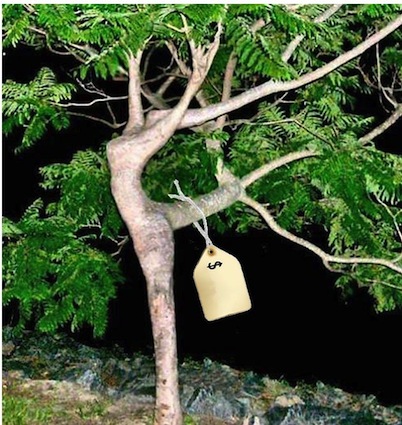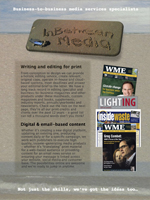We should price nature to protect it. That was the topic up for debate at the IQ2 event that attracted several hundred people in Sydney on July 21. ‘Price’ and ‘nature’ were the moving targets in this debate hosted by The Ethics Centre (formerly known as St James Ethics Centre). It seemed to be successful however in changing people’s minds, but why?
At the outset some 53% of attendees were on the affirmative side of the debate but only 36% retained their view at the conclusion. Some 20% took the negative position initially but this rose to 51%, with many from the ‘undecided’ category joining their ranks.
In speculating on why the shift occurred, it’s worth considering two possible causes: attendees re-framed their understanding of the topic up for the debate, and they focused on notions of value rather than price.
What became clear through the debate is that the statement being examined was not ‘should we price pollution or tax polluters’, but should we price nature itself.
This distinction more than anything could have led to the swing in audience opinion – a result of semantics – and perhaps that in itself is a valid outcome.
Even though one might argue for pricing mechanisms such as emissions trading schemes, the point made by those arguing the negative case is that those mechanisms are not putting a price on nature but rather on polluters.
This was further complicated by arguments that oscillated between notions of value and price. Of course one cannot put a price on nature said those arguing for the negative, it has an inherent value and cannot be subjected to obscene market-based analysis – it underpins our very existence. How can you argue with that? Clearly many audience members could not and Aunty Mary Graham, Aboriginal Elder & Philosopher, put it well: “I’ve found it a bit difficult actually to argue either/or… because I can see both sides actually.”
She said Aboriginal people, some of the poorest people in the nation, have a good understanding of the wealth that has come out of the Australian environment and where that wealth has gone. On the other hand, she said it’s imperative to talk about the problem from a political perspective.
“It’s as if people have taken hold just of the economics and the science of global warming and so on, but not looking at the really, really hard thing of what kind of political system will bring this through”.
Perhaps too, the community-framing of the issue by those arguing for the negative may have restored a sense of agency to audience members, especially those horrified by the idea of our precious natural assets being at the mercy of unstable global market forces and governments intent on achieving economic growth.
However the political focus of the team arguing the case for the negative, failed to engage on the point that pricing can be a strategic tool to gain improved environmental outcomes, without necessarily putting nature up for auction to the highest bidder.
Value and price
Greens Politician Larissa Waters, arguing for the negative, said pricing disguises the true challenge: “confronting powerful vested interests.
“When enough people assert the intrinsic value of something it will be protected,” she said.
Cullen Gunn, Agricultural & Ecosystem Investor disagreed: “Intrinsic value alone will not be enough for the future protection of nature.”
With 53% of Australia used for agriculture and privately managed, he believes nature protection in such areas should be considered nationally as another form of primary production.
When thinking about protection, Geoff Cousins from Australian Conservation Foundation (ACF) said it’s necessary to ask ‘protect it from what’?
“We have to start with the biggest single threat there is when we talk about protecting nature, and that’s climate change issues”.
When you have a leader who thinks fossil fuels are the future of mankind, then you need to consider pricing mechanism for protecting nature through investing in renewables, said Cousins.
Economist Richard Denniss, participating in the IQ2 debate for the negative, was right when he said that we don’t need to make nature more visible rather “We need to make the politics of the extractive industries visible”.
One thing we do know thanks to International Energy Agency research is that for every $1 spent to support renewable energy globally, $6 is spent on fossil fuel subsidies.
The Wentworth Group of Concerned Scientists believes we should use markets to conserve natural capital including, among other things, removing harmful subsidies.
“Subsidising or providing economic incentives for fossil fuels makes no sense because it results in increased costs to the environment, costs we will all have to bear sooner or later,” the paper said, referring to the $10 billion that goes to fossil fuel companies in Australia every year.
The group also said in its recent report, which suggests reforming the tax system, that exempting some industries from paying petrol excise on fuel used off-road also makes no sense, when at the same time we have a carbon tax or use taxpayer’s money for schemes to reduce greenhouse emissions.
Others would argue that the threats to nature come from other fronts: clear felling, Western consumerist culture, population growth, or all of the above. Each of these impacts requires a different strategy to protect nature, however, if the passion of communities is the only weapon we have, then we could be in trouble said speaker for the affirmative, Conservationist Penelope Figgis.
“We’re losing the battle… how do we turn it around?”
She made the point that nature should be made visible and real in economic decision making, adding that the “key shapers” of our future operate with an “ecological blindness” with the aim of growth.
She wants to make conventional economics “outmoded, seen as flat earth, foolish”.
“The economic valuation I’m talking about is not necessarily all the pricing mechanisms like offsets,” a point on which she agreed with the negative team who pointed out the flaws in Australia’s approach to biodiversity offsets.
“What I’m talking about are things like the TEEB studies… I can’t think of anything better to turn this country around,” she said, adding that more than 20 countries are now undertaking such studies.
A Country Study from The Economics of Ecosystems and Biodiversity (TEEB) identifies the ecosystem services that are vital to meeting the country’s policy priorities and makes recommendations on how these services can be integrated into policies. These recommendations depending on the country context, can include policies for poverty alleviation, subsidy reform, land use management, protected area management, securing livelihoods, to name a few.
A report from TEEB found that coal-fired power and cattle farming are the two most environmentally expensive industries — and cost the economy more in environmental damage than they generate in revenue.
It estimated that the global top 100 environmental externalities (the cost that affects a party who did not choose to incur that cost) are costing the economy worldwide around US$4.7 trillion a year.
For example, water is not usually priced according to how scarce it is, however the TEEB work found that the majority of environmental externality costs are from greenhouse emissions.
Figgis believes having such information available about our ecosystems will enable their value to come into decision-making at all levels and allow business to manage risks better and gain competitive advantage.
Returning to climate change
Let’s take Cousin’s example of climate change as the greatest single risk to nature and break it down further to see where pricing may offer some advantages to the environment.
A study in 2013, found that between them, just 90 companies have produced 63% of the cumulative global emissions of industrial carbon dioxide and methane between 1751 and 2010. All but seven of the 90 were energy companies producing oil, gas and coal. The remaining seven were cement manufacturers.
Fossil-fuelled electricity generation remains Australia’s largest industrial and corporate source of greenhouse emissions, responsible for more than half (54%) of the carbon pollution emitted (in that group) nationally last year, followed by coal mining, oil and gas, and metal manufacturing.
The ACF released a report earlier this year that showed that almost a third of Australian greenhouse emissions come from 10 companies – seven are energy companies and three are mining companies.
It’s not unexpected that industry is the greatest contributor to global warming, but it does reinforce economist Pavan Sukhdev’s comment: “Corporations determine two-thirds of the economy, and nothing will change unless they change”.
He believes that to turn around this “planetary time-bomb” companies need to move from a purely financial understanding of value to a wider understanding that takes externalities into account.
“We cannot manage what we do not measure and we are not measuring either the value of nature’s benefits or the costs of their loss. We seem to be navigating the new and unfamiliar waters of ecological scarcities and climate risks with faulty instruments” said Sukhdev.
Bringing together work over many years on calculating externalities such as emissions, water use etc, including the TEEB disclosure standards, the international framework for Integrated Reporting is currently in the early adoption phase. There are five companies in Australia involved in its development and more than one-third of Dutch listed companies are working on preparations for changing over to Integrated Reporting.
Most companies up until recent years that monitored or reported environmental performance, were simply accounting for their impacts in selective areas as compared to previous results and stated improvement targets.
The approach that is the closest to pricing ‘nature’ into business activities, would be the environmental profit and loss (E P&L) model pioneered by Jochen Zeitz when CEO of sports apparel retailer Puma. He told a business magazine in 2013: “Monetisation of environmental impacts is telling you in one page where your impacts are – and it is putting impacts into relationship [with each other].”
While not attempting to place a value on nature as such, an EP&L account places a financial value on environmental impacts along the entire value chain of a business to help it combine sustainability metrics with traditional business management.
Traditional approaches to environmental impact measurement provide a variety of metrics – for land use it is hectares, for carbon and other pollutants it is tonnes and for water it is cubic meters. This makes it difficult to compare the relative contribution of environmental impacts to the overall impact of a company or a product.
Valuing environmental impacts in financial terms solves this problem by providing an overarching metric to assess risk and opportunity, and enable direct comparison with the regular profit and loss account, which shows company´s net earnings.
In 2010 Puma’s environmental impact – based on the “cost to society of environmental damages” – was valued at €146 million ($208 million). What this allowed the company to see was that only 8% of its impacts were in its own operation, with the bulk in its supply chain. This then led to a whole new focus on better materials selection for instance.
Other approaches such as materiality reporting allow companies to place their activities in the context of the environments in which they operate, and actually demonstrate to stakeholders where the material risks and opportunities exist.
Put simply, instead of reading a 300-page sustainability report an investor would rather know how a company is going to supply water to its operation in years to come without depleting the declining local sources. Materiality assessment does ascribe a value to nature and while corporate structures require sustainability to come with a ‘business case’, the values will be expressed in dollar terms. If Integrated Reporting was mainstream though, it’s unlikely that some of the biggest environmental disasters in modern history would have occurred.
Figgis cited BHP’s disaster at OK Tedi: “Perhaps they may have built that tailings dam and not incurred very, very substantial costs”.
But aside from the metrics, we need to also remember that consumers have a significant role to play in influencing markets and responding to market failure which is how some have described climate change.
It was interesting when Larissa Waters asked audience members to raise their hands is they had done something to benefit the environment and then to indicate whether they had received a financial benefit. When many indicated ‘no’ to the second question she said it’s those values that drive people into environmental action that will ultimately serve to protect nature.
However it remains to be seen whether this will translate into people changing consumption habits, doing more with less. Are they prepared to pay more for goods and services that include the ‘true’ costs of producing it; to use renewable energy; to forgo the latest iPhone?
Stranger things have happened. Only last month it was reported that the world’s biggest miner, BHP Billiton, is in talks with European oil and gas companies on a possible global carbon emissions trading scheme.
The group of European companies including Royal Dutch Shell and BP, have approached the United Nations asking “to let them help governments devise a global carbon pricing plan to combat global warming”, according to the FT.
Would have been interesting to get BHP into the debate at IQ2. Maybe next time.



Comments are closed.